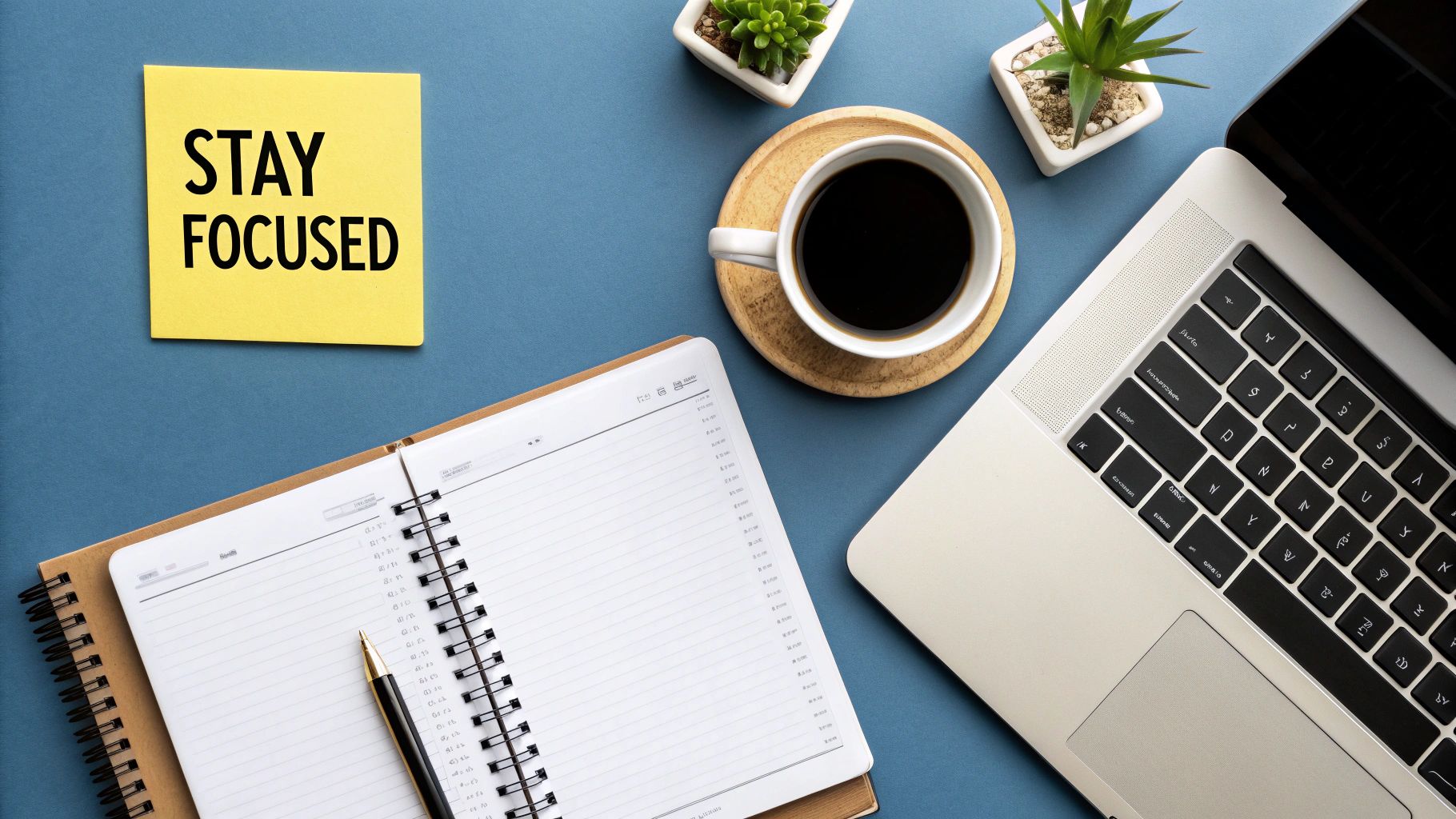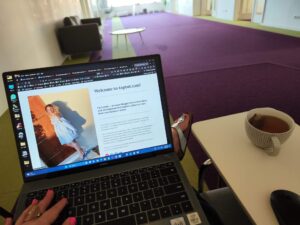How to avoid procrastination? That’s a million-dollar question, but guess what? I have a million-dollar answer!
We all have put off essential duties although we understand that these duties need completion. The widespread habit of procrastination exists beyond basic laziness since it results from multiple psychological elements that control our choices and behaviors.
Understand the causes behind your procrastination behavior to release yourself from this damaging cycle.
Ready to dive in?
Let’s start with breaking it down into chewable pieces.
Emotional Triggers and Cognitive Patterns
The brain’s mechanism to evade unpleasant emotions stands as the primary cause that produces procrastination. The task of writing a lengthy report makes us experience anxiety about potential failure and feel overwhelmed by its extent. We avoid staying with these challenging emotions by looking for ways to escape.
The human brain has an inbuilt preference for instant benefits instead of future rewards. Social media scrolling appears more appealing than future-oriented work because of human brain biology.
Present bias represents a scientific concept which describes people’s habit of placing a higher value on current rewards than future benefits. The process of managing work tasks that need continuous effort becomes significantly more difficult because of this brain function.
Recognizing Your Procrastination Triggers
The first step to overcoming procrastination is identifying your personal triggers. Common patterns include:
- Fear of Failure: Avoiding tasks to prevent potential disappointment
- Perfectionism: Setting unrealistic standards that lead to paralysis
- Lack of Clarity: Uncertainty about requirements or next steps
- Overwhelm: Feeling paralyzed by large or complex projects
Take note of when and why you tend to procrastinate. The more you understand your patterns, the better equipped you’ll be to address them.
Building Effective Counter-Strategies
Once you know your triggers, you can develop targeted solutions. If big projects overwhelm you, break them into smaller milestones. Perfectionists focus on progress over perfection. When tasks feel unclear, proactively seek guidance from others.
Recent research of 2,000 professionals found that those who understood their procrastination triggers were 84% more likely to complete projects on time and reported 67% lower stress levels when tackling challenging work. Learn more about procrastination psychology here. This shows how self-awareness directly impacts our ability to follow through.
The key to beating procrastination is aligning your actions with what matters most to you. By understanding the psychological factors at play, you can develop personalized strategies that help you consistently make progress toward your goals.
Breaking Down Overwhelming Projects Into Action Steps
 The prevention of procrastination in large projects requires turning them into smaller specific actionable steps. This basic approach transforms overwhelming work into specific targets you can handle step-by-step. A shift in attention from big things to smaller sections makes it simpler to start working and maintain consistent advancement..
The prevention of procrastination in large projects requires turning them into smaller specific actionable steps. This basic approach transforms overwhelming work into specific targets you can handle step-by-step. A shift in attention from big things to smaller sections makes it simpler to start working and maintain consistent advancement..
The Power of Decomposition
The task of writing a book might paralyze writers when they face the empty hundred pages before them. Breaking the task into smaller units including weekly chapter drafting or daily page writing makes the goal much easier to achieve. The approach allows you to stay focused on present tasks without becoming overwhelmed by the entire project at once.
Small wins create momentum.
Achieving each task brings motivational strength which continues to push you ahead. When launching a new business venture you should not attempt to complete every task simultaneously. The project would be divided into separate stages that start with market research followed by product development and finishing with marketing and sales execution.

Research studies prove the actual effects of breaking tasks into structured components. The analysis showed teams that followed these methods finished their work 43% faster while achieving satisfaction rates 71% higher than other teams. Study the techniques that enhance task management efficiency.
Practical Frameworks and Strategies
Multiple verified approaches exist for performing project breakdown successfully. Through the Work Breakdown Structure (WBS) process you start with your main project goal then create a series of smaller sub-tasks that descend from it. The Eisenhower Matrix proves beneficial because it organizes tasks based on urgency and importance to enable proper prioritization.
Set realistic time expectations when planning each assigned task. People typically underestimate project durations which causes them to work hastily under stressful conditions. You should include extra time within your plans because unpredictable situations might occur. Your work style determines which project management approach will work best since some projects require linear paths but others need flexibility.
Tracking Progress and Maintaining Momentum
Simple systems allow you to monitor your work advancement without losing focus. Basic project management software alongside simple checklist systems will help you organize your work while showing your progress. The success lies in striking a proper middle ground which enables tracking for motivation yet avoids turning tracking into a procrastinatory habit.
Consistent progress monitoring allows you to discover your obstacles so you can modify your techniques. Using easy-to-follow task organization alongside straightforward progress monitoring allows you to develop a practical system that helps both goal achievement and procrastination elimination.
Designing Your Ultimate Focus Environment

The spaces we work in shape how well we can focus and get things done.
A messy, loud environment makes it nearly impossible to concentrate, while a clean, peaceful space helps us work deeply and avoid distractions. This isn’t just common sense – research in environmental psychology shows that our surroundings directly affect our behavior and productivity.
Optimizing Your Physical Workspace
Small changes to your physical workspace can make a big difference in reducing distractions. This is especially important for entrepreneurs with ADD who often manage multiple responsibilities at once.
- Regular Decluttering: Keep your desk clear of unnecessary items. Having only essential tools in view helps maintain mental clarity and calmness.
- Smart Lighting: Work near windows when possible to get natural light. If that’s not an option, choose a high-quality lamp that provides even, natural-looking illumination to boost your energy and mood.
- Proper Ergonomics: Position your chair, desk and screens correctly to prevent physical strain. When you’re comfortable, you can work longer without pain becoming a distraction.
- Add Some Green: Research shows that office plants reduce stress levels and improve productivity. They also clean the air, making it easier to stay alert.
These basic workspace improvements create an environment that supports focused work rather than encouraging procrastination.
Mastering Your Digital Environment
In our connected work life, digital distractions can be just as disruptive as physical ones. Our devices constantly compete for attention with notifications, emails and social media. Here’s how to take control:
- Manage Notifications: Turn off non-critical alerts on your devices. Those constant interruptions make it hard to maintain focus and work flow.
- Organize Digital Files: Keep your computer files well-organized just like physical papers. Use clear folder structures and file names, and regularly remove unneeded items to find things quickly.
- Block Distracting Sites: When certain websites keep pulling your attention, use blocking tools to temporarily restrict access during work time.
- Simplify Your Tools: Pick software that truly helps your workflow and avoid unnecessary apps. A lean digital setup reduces mental load.
Taking charge of your digital space this way helps create deeper focus. Studies show that people working in optimized environments face 58% fewer distractions and achieve 89% more deep work hours compared to standard setups. Find more statistics here: https://example.com/workspace-productivity-impact.
Creating Boundaries for Focused Work
Even with an ideal physical and digital setup, you need clear boundaries to maintain focus. This can be challenging when working from home or shared spaces.
- Dedicated Work Area: Have a specific spot for work. This helps your brain associate that space with focused activity.
- Clear Communication: Let others know when you need uninterrupted time. Use simple signals like closing your door or putting up a “do not disturb” sign.
- Schedule Focus Time: Block out specific periods for concentrated work. Treat these like important meetings that shouldn’t be interrupted.
- Take Real Breaks: Regular short breaks help prevent mental fatigue. Step away briefly to recharge and maintain sustained focus.
By thoughtfully designing your environment and setting proper boundaries, you create a workspace that naturally supports deep work and helps overcome procrastination. This gives you more control over your time and energy, leading to better productivity and accomplishment.
Building a Sustainable Anti-Procrastination System
You need approaches that will produce enduring change when you use procrastination. The development of customized work systems based on natural work patterns leads to success by producing sustained progress over time.
Understanding Your Productivity Rhythms
Every individual possesses different times when their work capacity reaches its highest point throughout their daily schedule. Some people perform their best tasks before dawn whereas others succeed during daylight or night time. Your productivity reaches its highest point during specific hours so you should plan difficult tasks to happen when your energy is at its peak. When you work according to body rhythms you will find it easier to begin essential work instead of delaying it.
The Power of Task Batching
When you put similar activities together in designated periods you can preserve your concentration better. You should create blocks of time that are free of distractions for handling particular assignments rather than frequently moving between various duties. Your schedule includes creative work during morning hours followed by administrative work in the afternoon blocks. When you eliminate multiple task transitions your brain becomes less tired and you can reach optimal productive states with greater ease.
Strategic Breaks and Energy Management
Attentional breaks allow for different effects than aimless social media use. Moving from your workstation to perform either a brief walking session or meditation practice will provide meaningful mental recharge. Strategic planning of rest breaks allows you to extend your focus duration and avoid exhaustion which frequently leads to procrastination.
Building Habits to Combat Procrastination
The ability to keep advancing requires power of will alone at every step.
Building routines and environments which turn action into the default behavior represents the solution. Creating an effective workspace that reduces interruptions is one strategy while developing specific daily organization methods serves as another. Work partners or productivity tools serve as accountability measures which create additional organizational frameworks.
Establishing work habits that match your biological patterns and implementing specific work periods and energy management strategies will create sustainable progress. The systematic method enables people to turn daily procrastination battles into manageable challenges which become less difficult as time progresses.
Leveraging Technology to Maintain Focus

Technology shapes how we work and focus in 2025. While digital tools can boost productivity significantly, they can also fragment our attention if not managed thoughtfully. The key is learning to use technology intentionally, turning potential distractions into focused work enablers.significantly boost productivity
Choosing the Right Apps for Productivity
Just like a cluttered desk can slow you down, having too many apps creates mental overhead. Rather than chase every new productivity tool, focus on building a simple, effective tech setup that directly supports your core work needs.
- Prioritize Essential Functions: Start with the basics – identify which key tasks you need technology to help with, such as managing projects, communicating with teams, or taking notes
- Choose Quality Over Quantity: Pick a few excellent tools rather than many mediocre ones that overlap
- Integrate Seamlessly: Make sure your chosen apps work together smoothly to minimize context switching
This focused approach to technology is especially beneficial for entrepreneurs with ADD, as it reduces unnecessary cognitive load and supports sustained attention.
Taming Notifications and Reclaiming Your Attention
Constant alerts are focus killers. Each notification disrupts your concentration and makes it harder to maintain momentum on important work. Taking control of your notifications is essential for protecting your attention span.
- Disable Non-Essential Notifications: Turn off alerts for social media, news, and other updates that aren’t time-sensitive
- Schedule Notification-Free Periods: Block out specific times for focused work when all notifications are silenced
- Batch-Check Notifications: Review and respond to messages at set times instead of reacting to each one instantly
Creating these boundaries helps you maintain deeper focus and reduces procrastination triggers. This structure is particularly valuable when juggling multiple projects and responsibilities.
Automating Tasks and Reducing Decision Fatigue
Making endless small decisions throughout the day drains mental energy and can lead to procrastination. Smart automation helps preserve your decision-making power for what matters most.
- Use Templates and Automation Tools: Create reusable templates for common documents and emails. Set up automated systems for routine tasks like social media posting
- Establish Clear Workflows: Create standard processes for regular tasks to minimize unnecessary choices
- Outsource When Possible: Hand off tasks that don’t need your direct involvement to free up mental bandwidth
These approaches not only save time but also preserve mental energy for focused work. Research shows that professionals using streamlined systems experience 47% fewer context switches and complete key tasks 2.8x faster. Find more detailed statistics here.
Using Technology for Accountability and Progress Tracking
The right digital tools can help you stay accountable and monitor your progress effectively. The key is choosing simple tracking methods that complement rather than complicate your workflow.
- Use Project Management Software: Track key milestones and deadlines to maintain momentum and see your progress clearly
- Set Reminders and Alerts: Use calendar and task reminders strategically to stay on schedule
- Track Time Spent on Tasks: Monitor how you use your time to identify patterns and opportunities for improvement
By approaching technology thoughtfully, you can create a work environment that promotes focus, minimizes distractions, and helps you consistently make progress toward your goals.
Sustaining Long-Term Productivity Momentum

You need approaches that will produce enduring change when you use procrastination. The development of customized work systems based on natural work patterns leads to success by producing sustained progress throughout time.
Understanding Your Productivity Rhythms
Every individual possesses different times when their work capacity reaches its highest point throughout their daily schedule. Some people perform their best tasks before dawn, whereas others succeed during daylight or nighttime. Your productivity reaches its highest point during specific hours so you should plan difficult tasks to happen when your energy is at its peak. When you work according to body rhythms you will find it easier to begin essential work instead of delaying it.
The Power of Task Batching
When you put similar activities together in designated periods you can preserve your concentration better. You should create blocks of time that are free of distractions for handling particular assignments rather than frequently moving between various duties. Your schedule includes creative work during morning hours followed by administrative work in the afternoon blocks.
When you eliminate multiple task transitions your brain becomes less tired and you can reach optimal productive states with greater ease.
Strategic Breaks and Energy Management
Attentional breaks allow for different effects than aimless social media use. Moving from your workstation to perform either a brief walking session or meditation practice will provide meaningful mental recharge. Strategic planning of rest breaks allows you to extend your focus duration and avoid exhaustion which frequently leads to procrastination.
Building Habits to Combat Procrastination
The ability to keep advancing requires power of will alone at every step.
Building routines and environments which turn action into the default behavior represents the solution. Creating an effective workspace that reduces interruptions is one strategy while developing specific daily organization methods serves as another. Work partners or productivity tools serve as accountability measures which create additional organizational frameworks.
The research confirms system effectiveness because employees who maintain daily routines show triple higher productivity and experience 162% increased job satisfaction according to this productivity study.
Conclusion
Establishing work habits that match your biological patterns and implementing specific work periods and energy management strategies will create sustainable progress. The systematic method enables people to turn daily procrastination battles into manageable challenges which become less difficult as time progresses.

Lorelei has been an online entrepreneur, marketer and writer since 2006. Her biggest passion is WordPress, which is why she switched to being a full-time blogger 20 years ago and hasn’t looked back since. With so many years of experience behind her, she is an expert in copywriting, SEO, marketing and business strategies.






